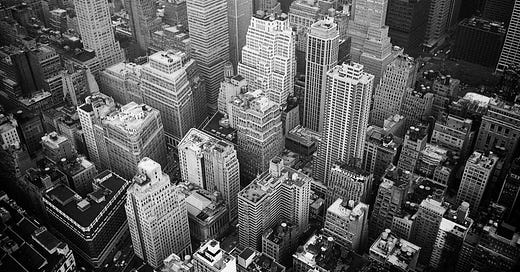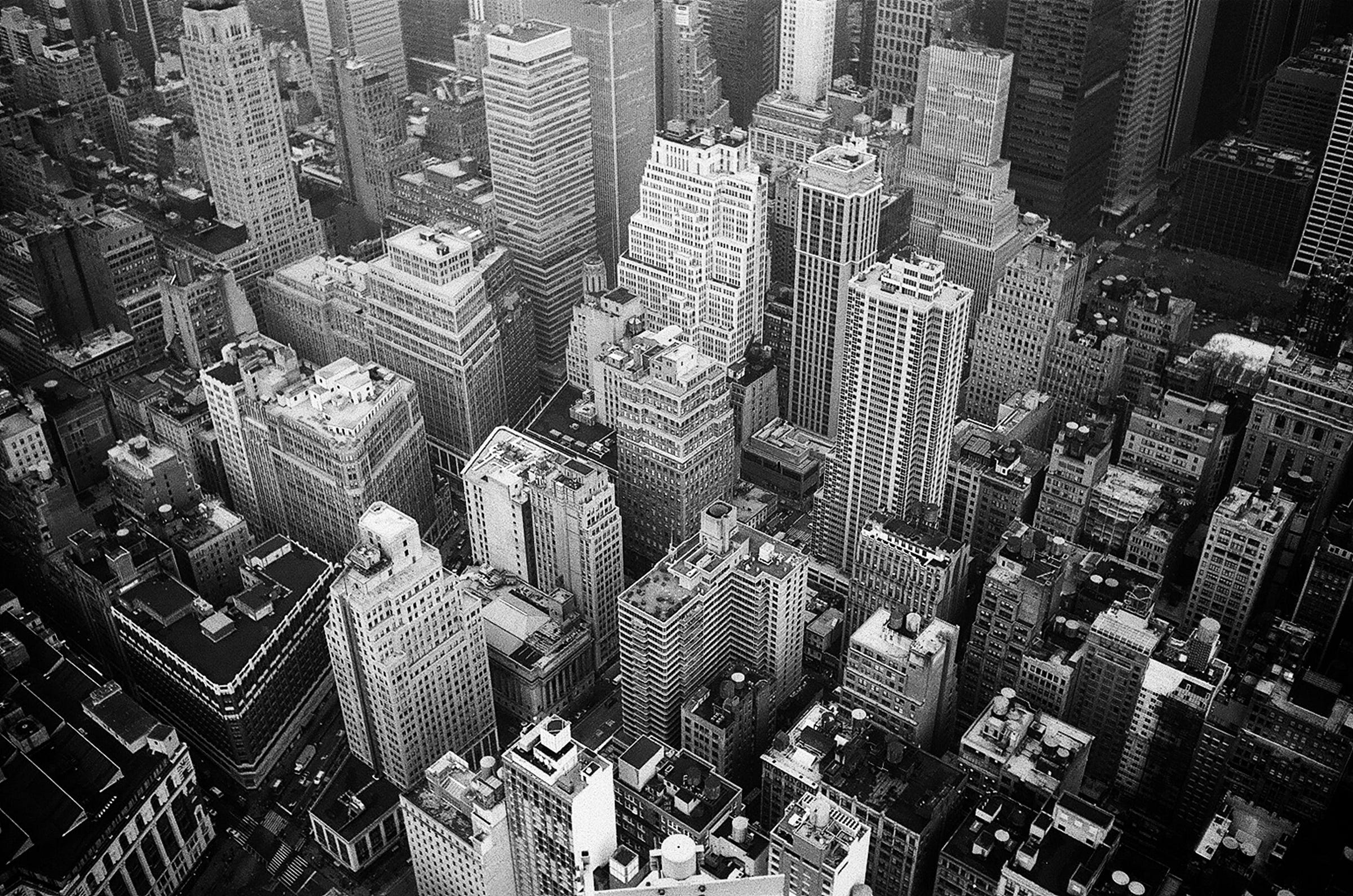Urban patriarchy
Cities were designed to accommodate corporations, cars, and the needs of men. It might be time to build anew.
Women in all cultures are expected to do very difficult, time consuming, laborious, and high-risk unpaid work to give birth and raise children, and in many cultures they remain as an almost entirely unpaid foundation of slave labor that the rest of the economy is built upon.
― Heather Marsh
Cities are not designed for people, they are not designed for you; they are designed to accommodate capitalist ideology.
Let me explain.
Residential, commercial, and recreational areas today are most often separated by broad car-friendly streets, effectively cutting them off from each other. It’s primarily men who benefit from this. This stems from the stereotype of the man as the provider, driving to and from work in a flashy car, while his wife stays at home, takes care of the children, and most often has to walk around for errands. It resulted in confined urban structures that are now difficult to change.
Activists have long advocated for the inclusion of women’s needs and interests in urban planning. This is known as gender-inclusive urban planning. In several European cities, these efforts have been part of official traffic and urban planning strategies for years now. However, most countries are still not even trying.
But how exactly are cities built for men rather than women? Traditional role models have weakened, haven’t they? At first glance — at least in terms of mobility — there appears to be little difference between men and women. In so-called ‘developed’ nations, women also drive cars, and men also walk. What is, in fact, the problem?
Invisible problems
According to studies, men and women still move in very different ways. Women drive roughly one-third fewer kilometers than men. At the same time, they cover significantly more kilometers on foot. Women would be the first to benefit from making cities more pedestrian-friendly.
Women are also much more likely to take on care-work and run errands. As a result, the routes they cover are more chain-like — shorter, with more stops, and less linear than those of men. In addition to their own jobs, they often have to take children to school, care for elderly relatives, go shopping, organize doctor’s appointments, and so on. A pile of unpaid and underappreciated work. When all these places are far apart or poorly connected, it mostly takes up the time and energy of women.
Furthermore, many women work part-time, which is why they are usually the hardest hit when there is a lack of available public transport connections outside of the traditional rush hours of a nine-to-five job — which is often the case.
There are differences in other areas as well. Women, for example, continue to be significantly underrepresented in the transportation industry and on city planning committees. As a result, their perspectives and needs are often overlooked. It’s the stereotypical and well-known ‘old white men deciding what’s best for everyone while having no clue how people other than them live.’
Poorly lit parks and back alleys
Another issue is women’s safety in cities. This particularly applies to poorly lit and little-frequented parks, dark and winding underground garages, back alleys, train stations, and remote or unmonitored public restrooms.
Underground passages, for example, are frequently narrow, dimly lit, and have only one entrance and exit. When more women participate in planning such passages, the design usually changes. The underpass is then designed to be brightly lit, wider, and equipped with additional exits. It’s not only about preventing violence, but also about improving women’s subjective sense of security in public places. There are entire areas and districts completely inaccessible to women on their own. Talk about equality.
Women usually have to be much more vigilant than men and adapt their routes to their sense of security. This costs time and causes stress and anxiety. To improve women’s safety in the city, squares and parks should not only be better lit, but also enlivened with additional cycle paths, benches, or playgrounds. There is safety in numbers. Also, safe, clean, and easily accessible public restrooms should be the norm and not the exception. Men have it much easier in this regard; it’s time to change that.
Gender-inclusive urban planning
While gender-inclusive urban planning received little attention until the 1990s, the issue has recently gained some traction in Europe. Sidewalks, for example, are now often built with enough space for parents pushing strollers and children walking alongside them.
In some cases, cities are actively involving local female residents to design parks and other public spaces. To strengthen girls’ and women’s subjective sense of security, facilities are then frequently designed to be more open, paths are better lit, and bushes or dead ends removed. All this can only be a starting point for further efforts, however. There’s still so much work to be done, particularly in areas where urban structures have grown historically — i.e. male-centered.
Breaking up stereotypes and role-models
But doesn’t gender-sensitive urban planning run the risk of reinforcing already outdated role models? For instance, by building cities that make it easier for women to walk with strollers and do care work?
Yes, it does. For this reason, efforts to reduce gender stereotypes must be undertaken simultaneously. For example, by encouraging girls to play on skate or basketball courts, which are usually dominated by boys. Or by building recreational areas and parks which serve a variety of interests and hobbies. Supposed gender-related attributes must be decoupled from urban structures. Cities and urban spaces should belong to everyone.
Ultimately, if places such as playgrounds, parks, supermarkets, and schools are more easily accessible on foot, fathers will also be more likely to take on childcare and other household responsibilities. Gender-inclusive urban development must go hand in hand with breaking up role models — not reinforcing them.
Cities of tomorrow
Breaking up stereotypes also requires ‘cities of short distances’ (often referred to as ‘compact cities’), in which all places of need can be reached safely by bike or on foot. The concept involves wider cycle paths and sidewalks, less congested streets, and improved public transport connections.
A prime example of a people-friendly city is Helsinki in Finland, where car speeds are limited to 30 kilometers per hour and lanes are clearly demarcated. This has effectively reduced deaths from traffic-related accidents to zero and made the city safer and more livable for everyone — but particularly women. Other examples include the ‘superblocks’ (huge car-free zones) in Barcelona and the ‘15-minute city’ concept in Paris. Ultimately, efforts to make cities more livable for people benefit not only women but all residents.
These concepts are also far more environmentally friendly and sustainable than existing structures. Roughly speaking: if men were to move around as women do, we would be much further ahead in terms of climate protection.
The vast amount of urban space currently dedicated to cars and parking lots causes harmful emissions and noise, contributes to global warming, and makes cities dangerous and uninviting. The city of the future is one without cars. It’s a city in which everything you need is within walking or cycling distance. A city where people know their neighbors and are involved in their communities. A friendly city, made for people. Here is one such vision, just… for some inspiration, you know? (it’s an ad, yeah, but still pretty cool):
Thanks for reading! For more Utopian visions check out my Solarpunk essays:
I’m author, writer, and activist Antonio Melonio, the creator of Beneath the Pavement. If you enjoyed this piece, please consider becoming a paid subscriber here on Substack or over on Patreon. It’s the best way to support Beneath the Pavement and help me put out more and higher-quality content.
If monthly contributions are not your thing (I understand), you can also leave me a tip or some coffee money over on PayPal. Thank you.
Sources and further reading
BBC. How ‘15-minute cities’ will change the way we socialise. https://www.bbc.com/worklife/article/20201214-how-15-minute-cities-will-change-the-way-we-socialise
City of Helsinki. No pedestrian fatalities in Helsinki traffic last year. https://www.hel.fi/en/news/no-pedestrian-fatalities-in-helsinki-traffic-last-year
Perez, C. C. (2021). Invisible Women: Data Bias in a World Designed for Men. Abrams Press.
The Conversation. Superblocks: Barcelona’s car-free zones could extend lives and boost mental health. https://theconversation.com/superblocks-barcelonas-car-free-zones-could-extend-lives-and-boost-mental-health-123295
The Guardian. Why are our cities built for 6ft-tall men? The female architects who fought back. https://www.theguardian.com/artanddesign/2021/may/19/why-are-our-cities-built-for-6ft-tall-men-the-female-architects-who-fought-back
The Wire. Our Cities Are Designed for Men, by Men. https://science.thewire.in/environment/our-cities-are-designed-for-men-by-men/
Tiikkaja, H., & Liimatainen, H. (2021). Car access and travel behaviour among men and women in car deficient households with children. Transportation research interdisciplinary perspectives, 10, 100367.





